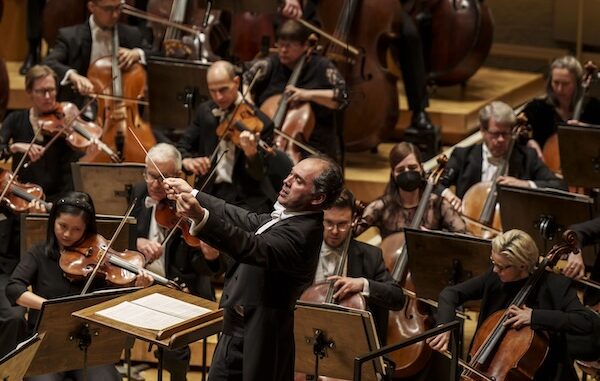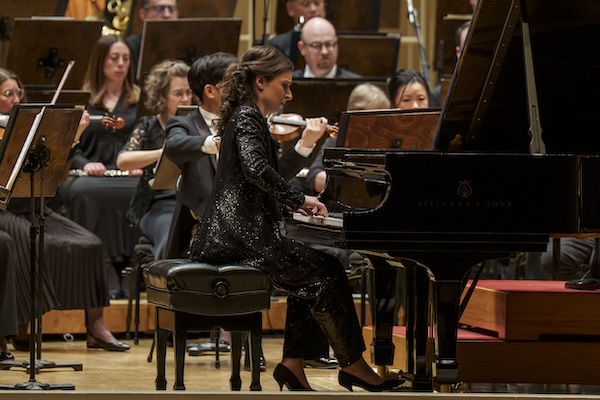
On April 18, 2024, in a program that was presented on the CSO at Wheaton Series on April 19 and at Symphony Center on April 20 and 21, Russian Conductor Tugan Taymurazovich Sokhiev led the Chicago Symphony Orchestra and Russian concert classical pianist Yulianna Avdeeva in an exquisite program at Symphony Center, 220 S. Michigan Ave., Chicago.
The evening began with the first Chicago Symphony performance of Sir Andrzej Panufnik’s inspiring Heroic Overture, 1952, revised 1969. Begun in 1939 after the invasion by Nazi Germany, in an effort to encourage Poland’s resistance, it was completed in 1952, 2 years before Panufnik left Communist Poland for England, where the work was revised in 1969. The short (6 minutes) piece is constructed around two major themes, the first a counterpoint to an inspiring patriotic song popular at the time of the work’s inception, the second introduced by violins and woodwinds in a unique rhythmic inversion and reversal. The overture ascends into dissonance comprised of major-minor clashes, skillfully controlled by Sokhiev, the CSO then performing a sequence of tight distinct repetitions, before a decisive- in the composer’s own words -“victorious” climax.

The Steinway grand was brought up and Yulianna Avdeeva, winner of the 2010 International Chopin Piano Competition, made her debut with The Chicago Symphony Orchestra in a splendid rendition of Frederic Chopin’s Piano Concerto No.1 in E Minor, Op. 11, 1830, followed in encore by that composer’s lovely and lilting Waltz in A-flat Major, Op. 42, 1934.
Chopin is rightly regarded as an incomparable genius, his works replete with nuance and sensitivity; Avdeeva, with her strength and virtuosity, dominated the instrument, yet conveyed a sense of intimacy in both pieces played.
The concerto opened with the full Orchestra producing a compelling theme, followed by the E Minor motif introduced in dual themes by the strings; the piano entered in stunning flourishes, reprising both themes with lush winds and horns supporting the melodies. Sokhiev, intent and expressive, directed the development as an inflation of the musical ideas, the first movement bringing the Orchestra and pianist together in a sudden duality. The second movement was lyrical, almost sad, a gentle, romantic reverie joining strings with piano. The Rondo, based on a Polish folk dance introduced first by the soloist, was lively, happy, with Avdeeva certainly leading; the Orchestra, encouraged with elegant flourish by Sokhiev, responsive, bouncy, joyous. The piece ends in a thrilling romp across the keyboard, the Orchestra responding with colorful closing chords.
The great Valse (Waltz), rich in harmony, is comprised of musical subtleties and intriguing harmonics, masterfully presented with depth and persuasion by Avdeeva. Opening with an intriguing trill, followed by the waltz rhythm and an interacting melody, after which motifs and tunes chase each other energetically to an assertive close, the waltz was presented as a showpiece by a showstopping pianist.
After the intermission, Sokhiev led the Orchestra in a jubilant recitation of Pyotr Ilyich Tchaikovsky’s Symphony No. 1 in G Minor, Op. 13, 1866, revised 1874, known as Winter Dreams. The composer referred to this symphony as “a sin of my sweet youth”. The first two movements also have descriptive titles, the allegro is called Daydreams of a Winter Journey, the adagio Land of Desolation, Land of Mists.

The 43-minute piece is a fountain of charming tunes, opening with a gorgeous melody by flute and bassoon, followed by a contrasting melody in clarinet, emerging into a brassy fanfare section; the development is eventful, then stops cold before the melodies reappear and end quietly. The second movement is slow and dreamy, opening with muted strings and oboe. This is once again followed by a contrasting melody, this time in the violas and flutes, and the two themes alternate while Sokhiev conducted gorgeous orchestral effects. The scherzo is a playful, rapid, unusual display of color, and the final movement, based on a Russian folk song, opens slowly with bassoons, followed by almost doleful violins before multiple full-orchestral melodies swirl fast and faster, slowing down before concluding with a grand finale.
All photos by Todd Rosenberg Photography
For information and tickets to all the fine programming of The Chicago Symphony Orchestra, go to www.cso.org




Be the first to comment